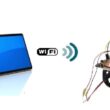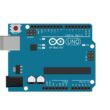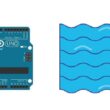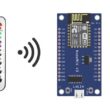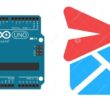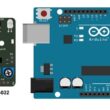Gas alarm system based on ESP32 board, MQ-4 sensor and LCD screen
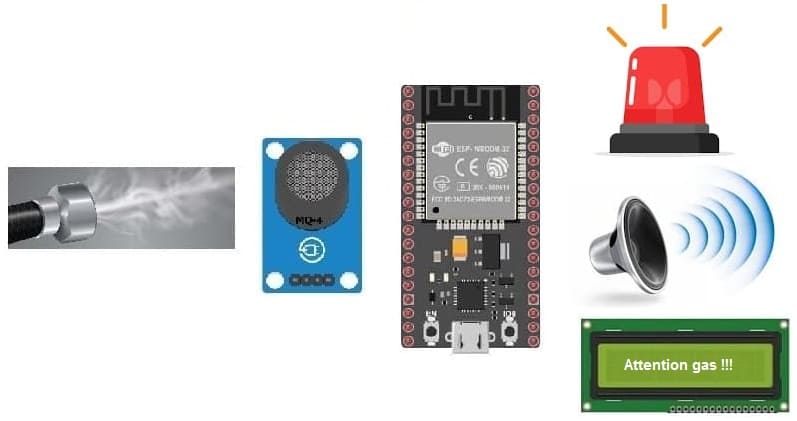
Tutorial plan
Introduction
1- How the gas alarm system ordered by ESP32 board works ?
2- Gas alarm system components
3- Mounting ESP32 board with MQ-4 sensor, LED, Buzzer and LCD screen
4- Program the ESP32 board to control the system
Introduction
A gas alarm system is a safety device designed to detect the presence of potentially harmful gases in an environment, such as carbon monoxide (CO), natural gas, propane, methane, or other combustible gases. These systems are commonly used in homes, commercial buildings, industrial facilities, and other locations where gas leaks could pose a threat to health and safety.
Here's how a typical gas alarm system works:
1- Gas Sensors: Gas alarm systems contain sensors that are capable of detecting specific types of gases. These sensors continuously monitor the air for the presence of gases, and when they detect a gas at a certain concentration level, they trigger an alarm.
2- Alarm Devices: When a gas is detected, the system activates alarm devices such as sirens, strobe lights, or audible alerts to warn occupants of the building about the potential danger. These alarms are usually loud and conspicuous to ensure they can be easily heard or seen.
3- Monitoring and Notification: In some cases, gas alarm systems are connected to monitoring services that can provide remote monitoring and notifications. This allows for immediate response in case of a gas leak, even if no one is present at the location where the alarm is installed.
4- Integration with Building Systems: Advanced gas alarm systems may be integrated with other building systems, such as ventilation systems or shut-off valves for gas lines. This integration allows for automated responses to gas leaks, such as activating ventilation to remove the gas from the building or shutting off the gas supply to prevent further leaks.
5- Maintenance and Testing: Regular maintenance and testing of gas alarm systems are essential to ensure their proper functioning. This includes periodic calibration of sensors, testing of alarm devices, and replacing batteries or other components as needed.
Overall, gas alarm systems play a crucial role in preventing accidents and protecting occupants from the dangers associated with gas leaks. They provide early warning of potential hazards, allowing people to take appropriate actions to mitigate the risks and ensure their safety.
How the gas alarm system ordered by ESP32 board works ?
The Gas Alarm System based on the ESP32 board, MQ-4 sensor, LCD screen, LED, and Buzzer is designed to detect the presence of potentially hazardous gases in an environment and alert users in case of a gas leak. Here's a detailed description of its components and how they work together:
1- ESP32 Board:
- The ESP32 is a powerful microcontroller with integrated Wi-Fi and Bluetooth capabilities, commonly used in IoT applications.
- It serves as the main controller of the system, responsible for reading sensor data, processing it, and controlling the output devices (LED, buzzer, and LCD).
2- MQ-4 Sensor:
- The MQ-4 sensor is a gas sensor specifically designed to detect combustible gases such as methane, propane, and butane.
- It operates on the principle of change in resistance when exposed to target gases.
- The sensor provides analog output proportional to the concentration of the detected gas.
3- LCD Screen:
- The LCD screen provides a visual interface to display important information to the user, such as gas concentration levels, system status, and alerts.
- It enhances the user experience by providing real-time feedback on gas detection and system operation.
4- LED:
The LED serves as a visual indicator to supplement the LCD screen. It provides a quick and easy-to-understand visual cue of the system status, such as normal operation or gas detection.
5- Buzzer:
- The buzzer serves as an audible alarm to alert users in noisy environments or situations where visual indicators may not be sufficient.
- It emits a loud sound when triggered by the system to grab the user's attention and indicate the presence of a gas leak.
System Operation:
- The ESP32 continuously monitors the output of the MQ-4 sensor to detect changes in gas concentration.
- When the gas concentration exceeds a predefined threshold (indicating a potential gas leak), the ESP32 triggers the alarm system.
- The LED lights up to provide a visual indication of the alarm, and the buzzer emits a loud sound to alert users audibly.
- Simultaneously, the ESP32 sends relevant information about the gas leak (e.g., gas type, concentration level) to the LCD screen for display.
- The LCD screen updates in real-time to provide users with critical information and instructions on how to respond to the gas leak.
- Users can take appropriate action, such as ventilating the area, shutting off gas valves, or evacuating, based on the information provided by the system.
Overall, the Gas Alarm System based on the ESP32 board, MQ-4 sensor, LCD screen, LED, and Buzzer provides an effective means of detecting and responding to gas leaks, enhancing safety in residential, commercial, and industrial environments.
Gas alarm system components
ESP32 Board:

The ESP32 is a powerful microcontroller developed by Espressif Systems. It's renowned for its integrated Wi-Fi and Bluetooth capabilities, making it a popular choice for various IoT (Internet of Things) applications.
MQ-4 gas sensor:
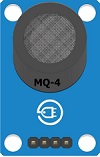
The MQ-4 gas sensor is a commonly used module for detecting the presence of methane (CH4), a flammable gas commonly found in natural gas and industrial environments.
LCD I2C 1602 Display:
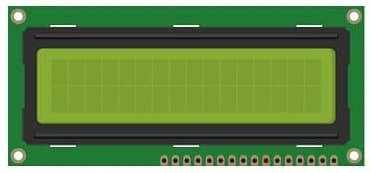
The LCD I2C 1602 display is a type of liquid crystal display (LCD) that utilizes the I2C (Inter-Integrated Circuit) communication protocol to interface with microcontrollers or other devices.
The LCD screen is used to display the alert message in case of gas leak detection.
LED
![]()
In an obstacle detection system, an LED (Light Emitting Diode) can be used as a visual indicator to provide feedback about the detection status. The LED can be programmed to turn on or off based on whether an obstacle is detected within a certain range.
Buzzer
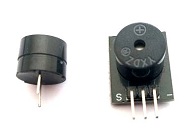
The buzzer in a gas alarm system serves as an audible alert to warn occupants of a potential gas leak
Jumper Wires:

For making temporary connections and wiring between components.
Breadboard:

A breadboard is a useful tool for creating temporary electronic circuits. It allows you to connect components without soldering.
Mounting ESP32 board with MQ-4 sensor, LED, Buzzer and LCD screen
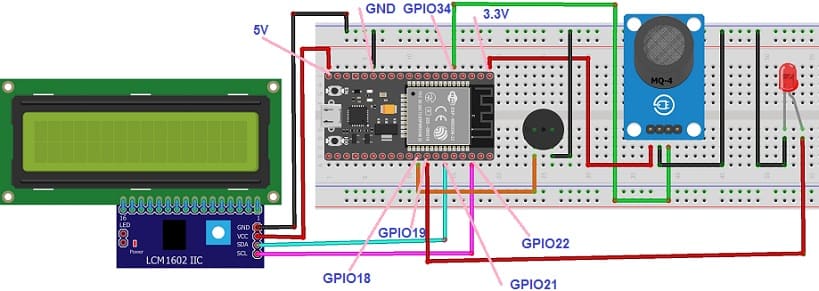
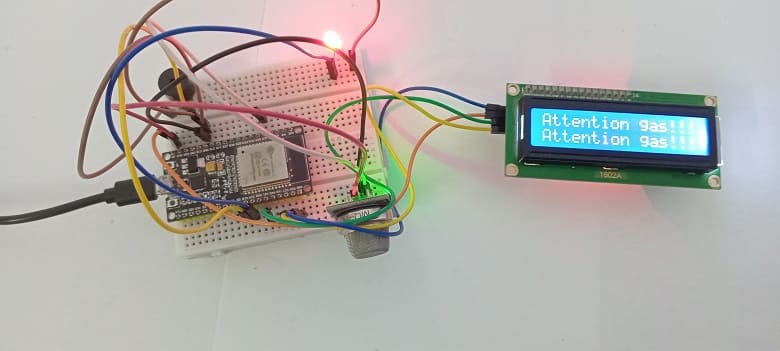
Attaching the MQ-4 sensor :
- Connect the VCC pin of the MQ-4 sensor to the 5V pin of the ESP32 board
- Connect the GND pin of the MQ-4 sensor to the GND pin of the ESP32 board
- Connect the DO pin of the MQ-4 sensor to the GPIO34 pin of the ESP32 board
Attaching the LCD I2C 1602 Display :
- Connect the SDA (data line) of the LCD I2C 1602 display to GPIO21 pin of ESP32 board.
- Connect the SCL (clock line) of the LCD I2C 1602 display to GPIO22 pin of ESP32 board.
- Connect the VCC pin of the LCD I2C 1602 display to the 5V pin of ESP32 board.
- Connect the GND pin of the LCD I2C 1602 display to GND pin of ESP32 board.
Attaching the buzzer :
- Connect the (+) terminal of buzzer to GPIO18 pin on the ESP32 board.
- Connect the (-) terminal of buzzer to GND pin on the ESP32 board.
Attaching the red LED :
- Connect the negative terminal (cathode) of each LED to the ground (GND) of the ESP32 board.
- Connect a resistor between the GPIO19 pin and the positive terminal (anode) of the LED
Program the ESP32 board to control the system
To program the ESP32 board to detect a gas leak using the MQ-4 gas sensor and display an alert message on an LCD screen with MicroPython, you'll first need to:
1- ensure MicroPython is installed on your ESP32
2- flash your ESP32 with MicroPython using this file esp32-20210902-v1.17.bin
3- import this two libraries : i2c_lcd and lcd_api for I2C LCD screen
4- use the following code:
|
1 2 3 4 5 6 7 8 9 10 11 12 13 14 15 16 17 18 19 20 21 22 23 24 25 26 27 28 29 30 31 |
from machine import Pin, SoftI2C, ADC from lcd_api import LcdApi from i2c_lcd import I2cLcd from time import sleep I2C_ADDR = 0x27 totalRows = 2 totalColumns = 16 #initializing the I2C method for ESP32 i2c = SoftI2C(scl=Pin(22), sda=Pin(21), freq=10000) lcd = I2cLcd(i2c, I2C_ADDR, totalRows, totalColumns) # Pin assignments redled_pin=Pin(19, Pin.OUT) buzzer_pin=Pin(18, Pin.OUT) gaz = ADC(Pin(34)) gaz.atten(ADC.ATTN_11DB) while True: gaz_value = gaz.read() <span class="hljs-comment"># Read analog value from MQ-4 sensor</span> if (gaz_value<1000): # Check if gas concentration exceeds threshold lcd.putstr('Attention gas!!!') # print alert message # Activate LED and buzzer redled_pin.value(1) buzzer_pin.value(1) else: lcd.clear() # Deactivate LED and buzzer redled_pin.value(0) buzzer_pin.value(0) sleep(0.5) |
This program initializes the pins for the LED, buzzer, and MQ-4 sensor, as well as the I2C communication for the LCD screen. It then defines functions to read the gas concentration from the sensor and to trigger or reset the alarm based on the concentration level. The main loop continuously reads the sensor data, checks it against the threshold, and activates or deactivates the alarm accordingly. The LCD screen displays appropriate messages based on the alarm status.















